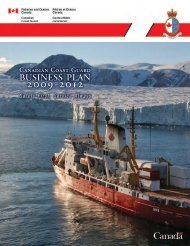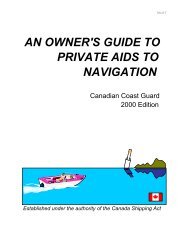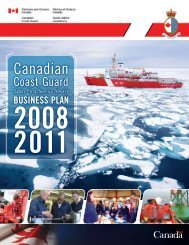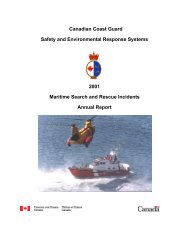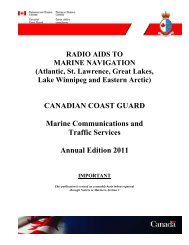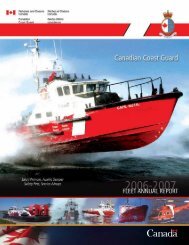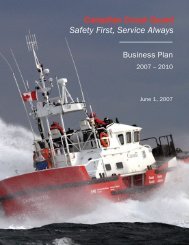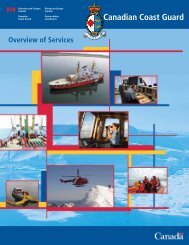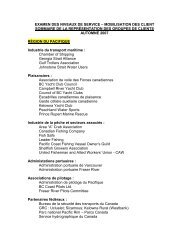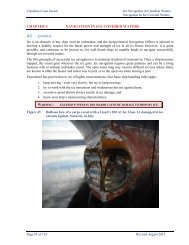PART 4 - Canadian Coast Guard
PART 4 - Canadian Coast Guard
PART 4 - Canadian Coast Guard
Create successful ePaper yourself
Turn your PDF publications into a flip-book with our unique Google optimized e-Paper software.
TRANSPORT CANADA’S REQUIREMENTS FOR THE GLOBAL MARITIME DISTRESS AND SAFETY SYSTEM<br />
(GMDSS) AND GUIDANCE ON IMPORTANT OPERATIONAL ALERTING PROCEDURES<br />
Masters and radio operators are urged to review and use the following important information on the use of GMDSS radio<br />
equipment to help ensure the GMDSS and Search and Rescue (SAR) services can operate as efficiently and effectively as<br />
possible.<br />
New Regulations<br />
Following several years of development and consultation, the new Ship Station (Radio) Regulations, 1999 and the new<br />
Ship Station (Radio) Technical Regulations, 1999 came into force on April 1, 2001. These Regulations affect <strong>Canadian</strong><br />
domestic ships operating on the seacoasts of Canada, which are not in a Vessel Traffic Services Zone, and that:<br />
• are 20 metres in length or more and certified to carry more than 12 passengers; or<br />
• have a gross tonnage of 300 tons or more<br />
These ships will be carrying and using new radio equipment consistent with the GMDSS.<br />
The new regulations also phase-in requirements over the next couple of years that will apply to smaller commercial ships<br />
operating on the seacoasts of Canada (Note in particular that by April 1, 2002, vessels 8 metres or more in length and<br />
operating more than 20 miles from shore will need an EPIRB. By February 1, 2003, tow boats, vessels carrying more<br />
than 6 passengers and vessels of closed construction more than 8 metres in length will need a VHF/DSC radio). In<br />
addition, amendments have been made to other regulations to update the requirements pertaining to survival craft radio<br />
equipment e.g., Life Saving Equipment Regulations, Small Fishing Vessel Inspection Regulations and the Large Fishing<br />
Vessel Inspection Regulations. The following table summarizes the carriage requirements of the Ship Station (Radio)<br />
Regulations, 1999. However the actual regulations should be consulted for specific requirements and are available at:<br />
http://www.tc.gc.ca/acts-regulations/GENERAL/C/CSA/menu.htm<br />
EMERGENCY POSITION INDICATING RADIO BEACONS (406 MHZ)<br />
It is recommended that a float-free EPIRB be carried on board ships and pleasure crafts operating offshore. To be<br />
effective, 406 MHz EPIRBs must be registered in the National SAR Secretariat’s 406 MHz <strong>Canadian</strong> Beacon Registry<br />
you can register your 406 MHz EPIRBs by (telephone at 1 800 727-9414 by facsimile 613-996-3746) or on the Website<br />
at: http://www.nss.gc.ca/site/cospas-sarsat/emergencyBeacon_e.asp<br />
Inmarsat announced that they discontinued their monitoring service of INMARSAT “E” EPIRB distress alerts as of<br />
December 1, 2006: http://support.inmarsat.com/announce/00018994.aspx?language=EN&textonly=False.<br />
Mariners should check with INMARSAT for exchange of any currently held INMARSAT ‘E’ EPIRBs. Further, mariners<br />
should only purchase and fit COSPAS-SARSAT 406 MHz EPIRBs.<br />
• Float-free EPIRBs should not be fitted under ledges or structures that would impede their ability to float free.<br />
Do not install the EPIRB with lanyard attached to the superstructure of your vessel.<br />
• Both manually activated EPIRBs and float-free EPIRBs should be readily accessible so that in the event of an<br />
emergency, it is available for immediate use.<br />
• EPIRBs should be tested using the "TEST" button, by the operator every 6 months. This test should be recorded in the<br />
radio log.<br />
• EPIRB battery packs and hydrostatic release units should be replaced per the manufacturer’s recommendations.<br />
A list of 406 MHz EPIRBs approved for use in Canada is available on the Website at:<br />
http://www.tc.gc.ca/MarineSafety/APCI-ICPA/default.asp<br />
4-16



